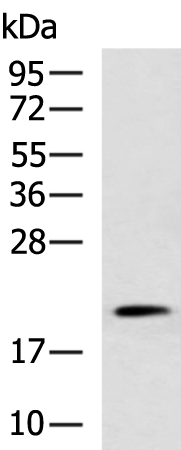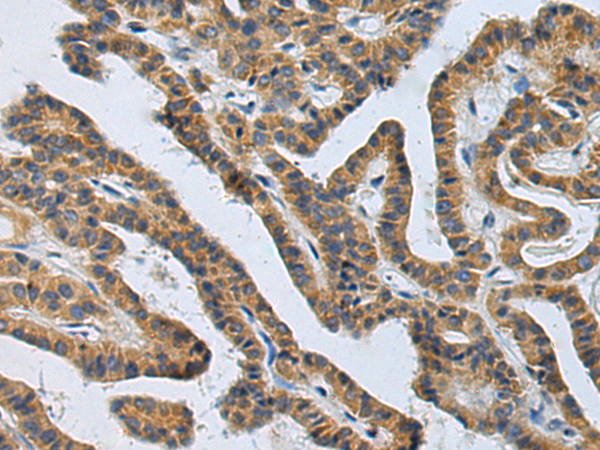

| WB | 1/1000 | Human,Mouse,Rat |
| IF | 咨询技术 | Human,Mouse,Rat |
| IHC | 1/100-1/500 | Human,Mouse,Rat |
| ICC | 技术咨询 | Human,Mouse,Rat |
| FCM | 咨询技术 | Human,Mouse,Rat |
| Elisa | 咨询技术 | Human,Mouse,Rat |
| Aliases | GAF; FGF-9; SYNS3; HBFG-9; HBGF-9 |
| WB Predicted band size | 23 kDa |
| Host/Isotype | Rabbit IgG |
| Antibody Type | Primary antibody |
| Storage | Store at 4°C short term. Aliquot and store at -20°C long term. Avoid freeze/thaw cycles. |
| Species Reactivity | Human, Mouse, Rat |
| Immunogen | Fusion protein of human FGF9 |
| Formulation | Purified antibody in PBS with 0.05% sodium azide and 50% glycerol. |
+ +
以下是关于SLC22A1抗体的3篇代表性文献概览:
---
1. **文献名称**:*"Organic cation transporter 1 (OCT1) modulates multiple cardiometabolic traits through effects on hepatic substrate utilization"*
**作者**:Chen EC et al.
**摘要**:该研究通过免疫组化和Western blot技术,利用SLC22A1抗体探究了OCT1在小鼠肝脏中的表达及其对代谢底物转运的影响,发现OCT1缺失会改变脂质和葡萄糖代谢,提示其在代谢疾病中的潜在作用。
---
2. **文献名称**:*"Species-specific involvement of organic cation transporter 1 in hepatic metformin uptake"*
**作者**:Nies AT et al.
**摘要**:通过跨物种比较(人、小鼠、大鼠)的免疫荧光和蛋白质印迹实验,使用SLC22A1抗体揭示了OCT1在不同物种肝脏中表达差异,并证明其与二甲双胍药物转运效率的关联,为临床前研究提供参考。
---
3. **文献名称**:*"Immunolocalization of OCT1 in human hepatocellular carcinoma and its prognostic significance"*
**作者**:Kimura N et al.
**摘要**:研究利用SLC22A1抗体对肝癌组织进行免疫组化分析,发现OCT1蛋白表达水平与患者生存率及化疗反应显著相关,提示其作为肝癌预后生物标志物的潜力。
---
这些文献展示了SLC22A1抗体在代谢研究、跨物种药理学及肿瘤预后等领域的应用,涵盖免疫印迹、免疫组化等实验方法。如需扩展,可进一步检索近年研究以补充最新进展。
The SLC22A1 antibody is a tool used to detect and study the solute carrier family 22 member 1 (SLC22A1), also known as organic cation transporter 1 (OCT1). SLC22A1 is a transmembrane protein primarily expressed in the liver, where it facilitates the uptake of organic cations, including endogenous compounds (e.g., thiamine, dopamine) and xenobiotics (e.g., metformin, cisplatin). It plays a critical role in drug disposition, pharmacokinetics, and detoxification processes. Structurally, SLC22A1 consists of 12 transmembrane domains with intracellular N- and C-termini, and its activity is influenced by genetic polymorphisms that impact drug efficacy and toxicity.
Antibodies targeting SLC22A1 are essential for investigating its expression, localization, and function in physiological and pathological contexts. They are widely used in techniques like Western blotting, immunohistochemistry, and immunofluorescence to assess protein levels in tissues or cell models. Research applications include studying hepatic drug transport mechanisms, metabolic diseases (e.g., diabetes), and cancer, where altered SLC22A1 expression may correlate with chemotherapy resistance or disease progression. For instance, reduced SLC22A1 in hepatocellular carcinoma has been linked to impaired drug uptake, affecting treatment outcomes.
These antibodies also aid in exploring genetic variants' functional consequences and their associations with interindividual variability in drug responses. Validation of SLC22A1 antibodies typically involves knockout controls or overexpression systems to ensure specificity, given the homology among SLC22 family transporters. Overall, SLC22A1 antibodies are vital for advancing research in pharmacology, toxicology, and personalized medicine.
×